Crouching in the silvery glow of a curvaceous moon, I silently hoped for a face-full of sand. OK, so it sounds a bit perverse now, but as I watched the lone green turtle burrow into the beach, her clumsy flippers flinging the grains high into the air, I wanted to experience it with all of my senses – however gritty it got.
The turtle stopped her scooping, resting silently for a minute. She fixed us with an unblinking eye. The lights of distant fishing boats danced on the shimmering sea and a gentle wind whispered in our ears, but we barely noticed. This was the first night of our road trip along Oman’s untamed coast, a journey that had begun just a few hours ago – and we were already lost for words.
Innately programmed to lay – and bury – her eggs on the same beach where she had hatched, she had swum thousands of miles to Ras al Jinz beach just for this moment, from waters as far-flung as Yemen, Somalia and the Maldives. Like a hefty boulder, her metre-long shell was half-hidden by sand, her flippers limp at her sides.
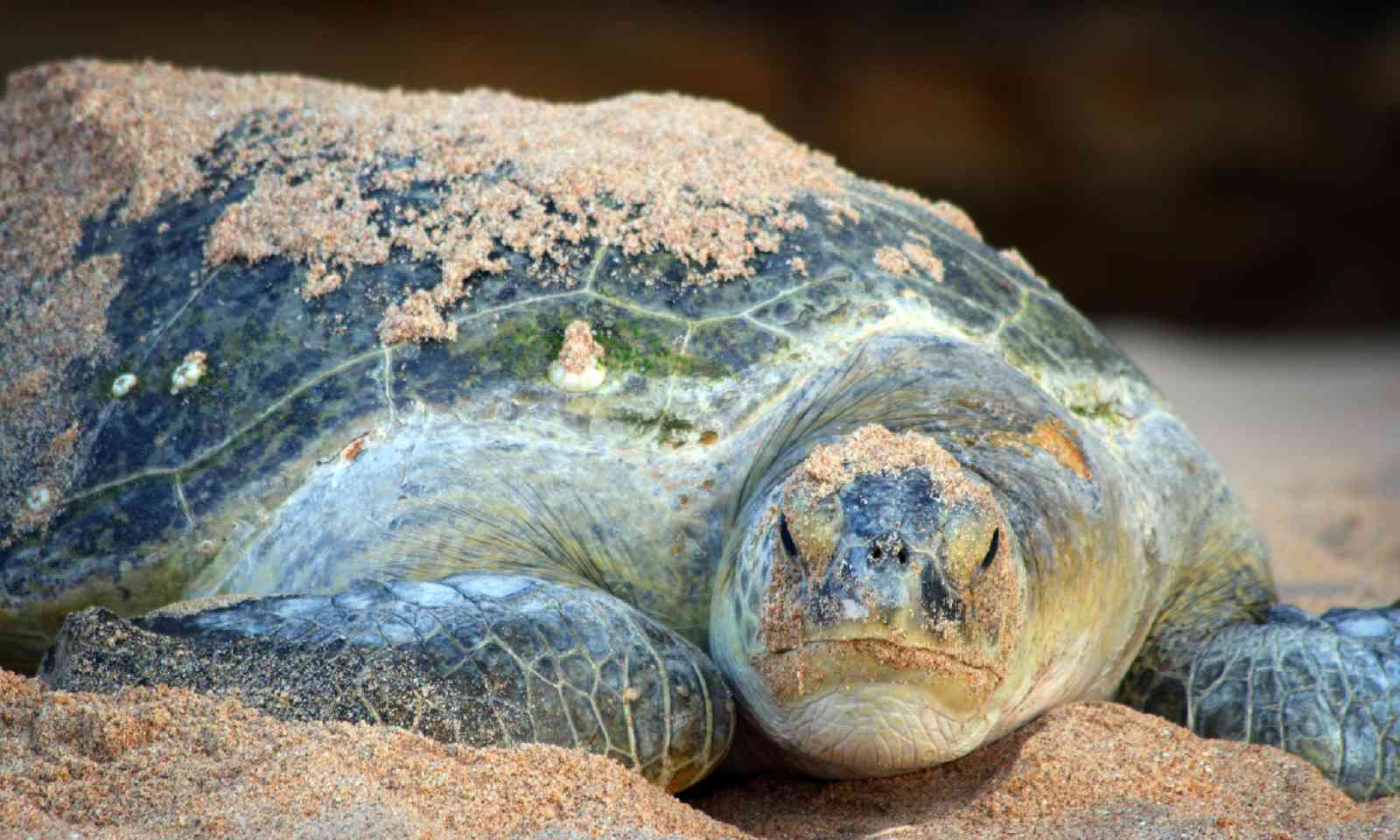
Green turtle at Ras al Jinz (Dreamstime)
The screech of a mobile interrupted our reverie. “No cameras, no phones, no torches, no loud talking,” turtle ranger Hamad had warned at the start of the tour, lest we disturb the turtles. So when he fished his phone from his pocket, we bristled as he spoke in increasingly excitable Arabic.
“There is a group of newly-hatched turtles that are heading to the sea,” he translated. “Follow me!” All forgiven, we stumbled over the dunes in his wake, leaving the green turtle to her slog.
We were almost too late. A clutch of tiny turtles, each no bigger than my palm, were stumbling across the wet sand. They too were facing a Herculean task: to navigate the beach on flailing flippers and find the nearest wave.
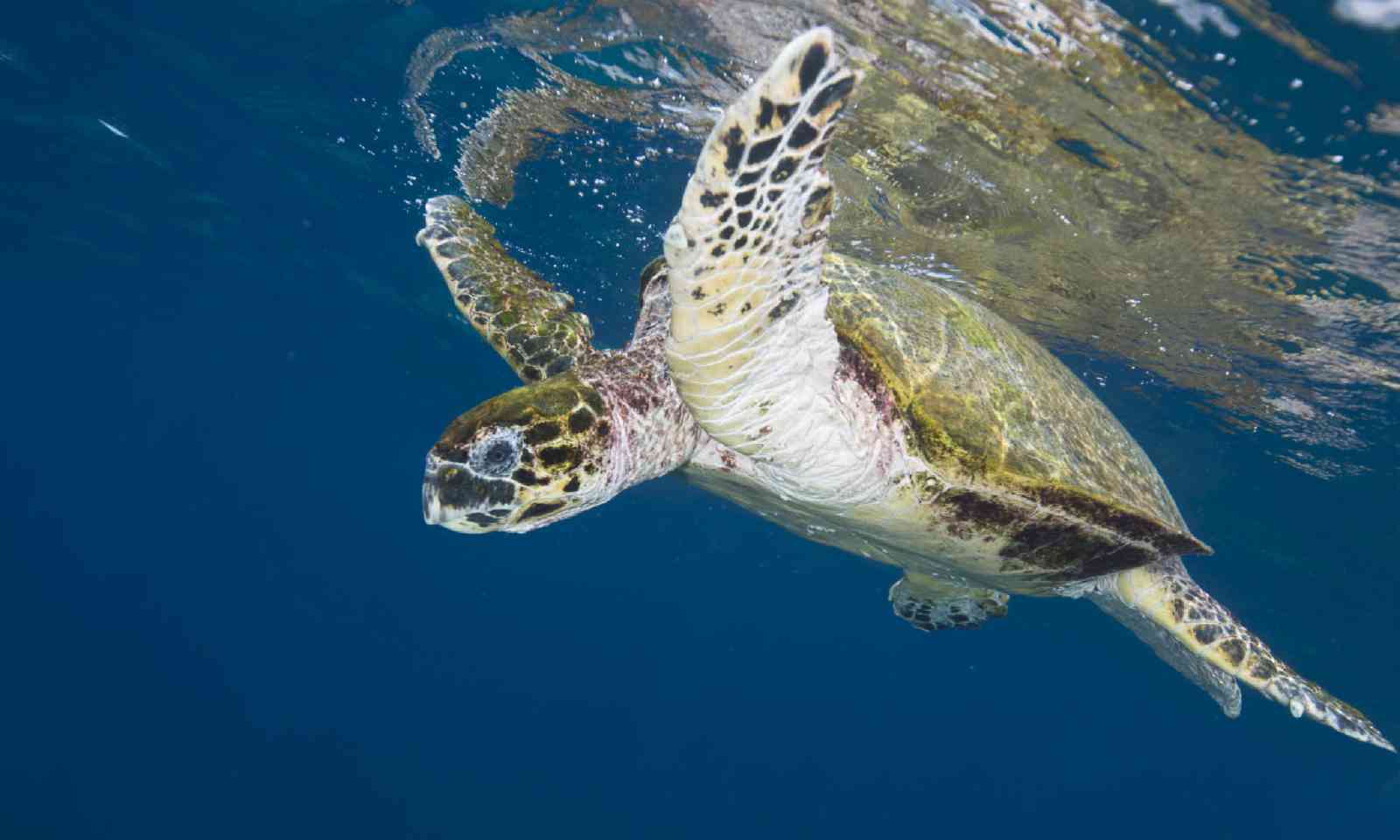
Green turtle swimming off the coast of Oman (Shutterstock)
“They have beaten the odds to get to the sea,” whispered Hamad. He pointed to a patch of sand just metres away, cross-crossed with different animal tracks. “Those are the footprints of the foxes and crabs that feed on turtle eggs. The birds – see, circling up there? – they also eat them. Only about two in one thousand turtles survive until maturity.”
When the last of the hatchlings disappeared into the surf, we retraced our own footprints back to the mother turtle. She too was inching her way to the sea, ready to slip back into its shadowy waves. I glanced up at the gulls, eerily silent above us, and hoped that her long night of laying wasn’t in vain. A tide of seawater swooshed up the sand – and with that, the turtle was gone.
In just one week, my partner and I aimed to cover 1,300km, wild camping wherever we could. Our route, marked on a map in pink highlighter, would take us in a loop from Muscat down to Masirah Island – along the coast – before heading inland to the Western Hajar mountains. It was an ambitious plan, but Oman boasts an ever-growing network of fine roads and some of the cheapest fuel prices on the planet. A litre of super-unleaded petrol costs 120 Omani Baisa: just 20 pence.
The highway from Ras al Jinz to Shannah skirts the coastline, 300km of smooth asphalt sandwiched between sea and perilous sand dunes. As we ate up the kilometres, the turquoise ocean unfurled on our left, the occasional dhow fishing boat bobbing on the blue.
On our right, visions of picturebook Arabia: rolling white dunes, sizzling in the late morning sun. It was March, so temperatures hovered modestly in the mid twenties – but out there in the desert it looked hot, hot, hot.

Camels on the road – a common sight (Hazel Plush)
Signs warned of camels, a peril we only half-believed until we whizzed past a pair lolloping along the highway. As they shrank in the rear-view mirror, fuzzy with heat haze and dust, I wondered what they thought of this road through their desert home.
Until a few decades ago, there were only 9km of tarmac roads in the whole country. Oman was languishing under the oppressive rule of Said bin Taimur, its population impoverished and illiterate. Taimur confined the country’s wealth to his Muscat quarters, living in luxury while his subjects scratched out meagre livelihoods as farmers, traders, and fishermen.
But in July 1970, Taimur’s son seized power – and everything changed. Qaboos bin Said Al Said channelled the country’s oil money into education, amenities, roads and housing. “My father doesn’t recognise his country now,” our guide Ahmed had said on our first day’s tour of Muscat. “When he was a boy, he lived in one room with his parents and eight brothers – now, we have everything we could ever need. People love the Sultan.”

Time for a quick coffee? (Hazel Plush)
I eyed the door of a weather-beaten coffee shop, a lone dog sleeping under its half-closed shutters. After three hours of driving, a hit of sweet cardamom-scented Arabic coffee would shake off the fug of the road – but there was no time to stop. We had a boat to catch, to Masirah Island.
In the harbour, a rusting car ferry rocked amongst an elegant fleet of wooden dhows. Their hand-crafted curves spoken of Oman’s seafaring traditions, the country’s love and deep respect for its bounteous waters. Our steed, however, chugged ungracefully as we boarded – the fifteenth and final vehicle on deck.
Out on the sapphire waves of the Arabian Gulf, we were tossed like bath toys by the ever-growing swell. There was nowhere to sit but the car, so I copied the local families, businessmen and traders around us, and reclined my seat for a kip. For 90 minutes we snoozed our way eastwards, in a cloud of diesel fumes and hopeful seagulls.
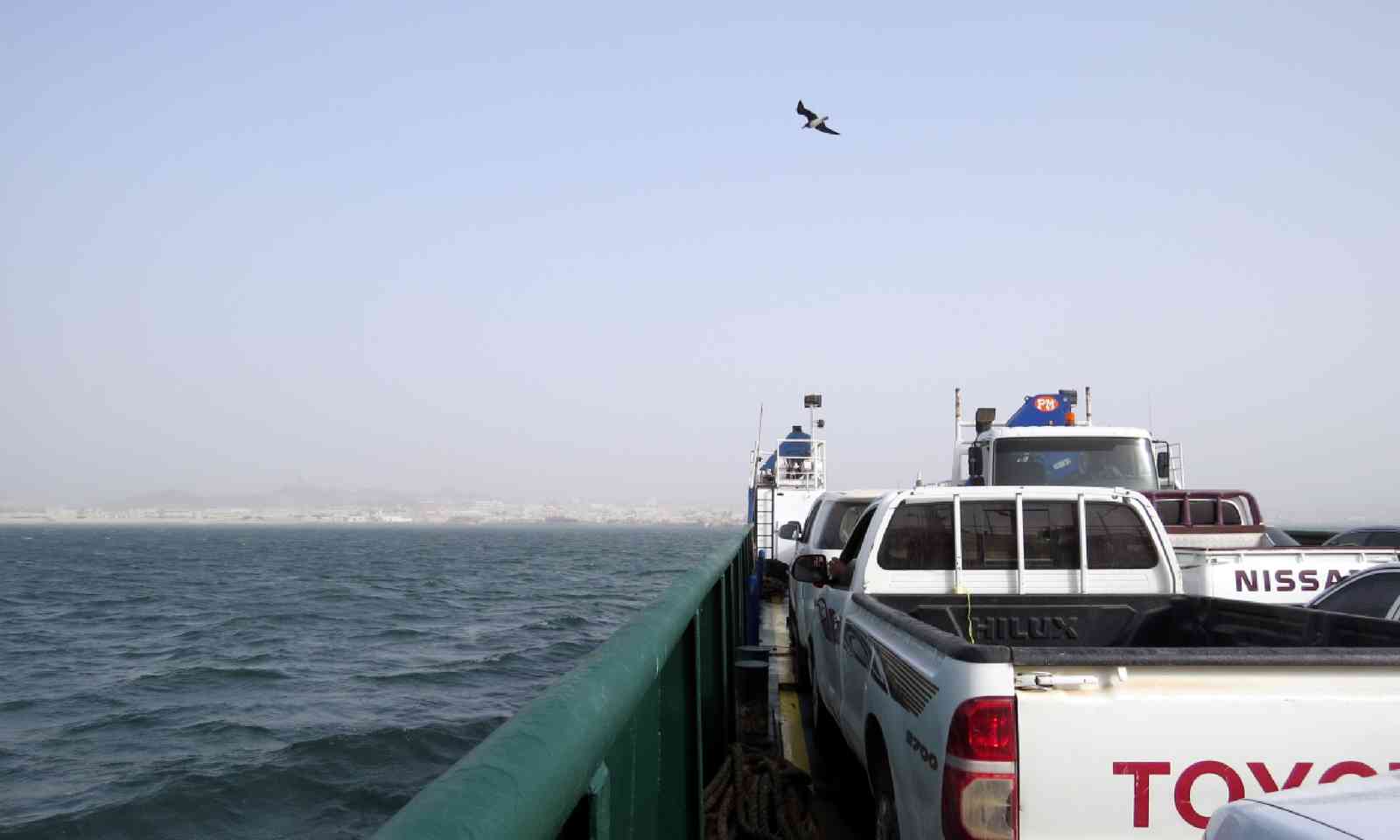
The car ferry to Masirah Island (Hazel Plush)
Our destination? Unknown. We’d read about Masirah’s sprawling beaches – boundless stretches of untouched sand and towering dunes, perfect for wild camping. The island is just 95km long and 14 km wide, circled by a single road – so we threw caution to the wind and turned left, towards the waning sun.
It was the camels that led us to the perfect camping spot. We’d slowed to admire them as they sashayed along the beach, the golden fluff on their humps ruffling in the breeze. While I hung out of the window taking photos, my partner swung the car onto the shingle, facing the darkening sea. We’d arrived. The claps of the waves applauded our choice.
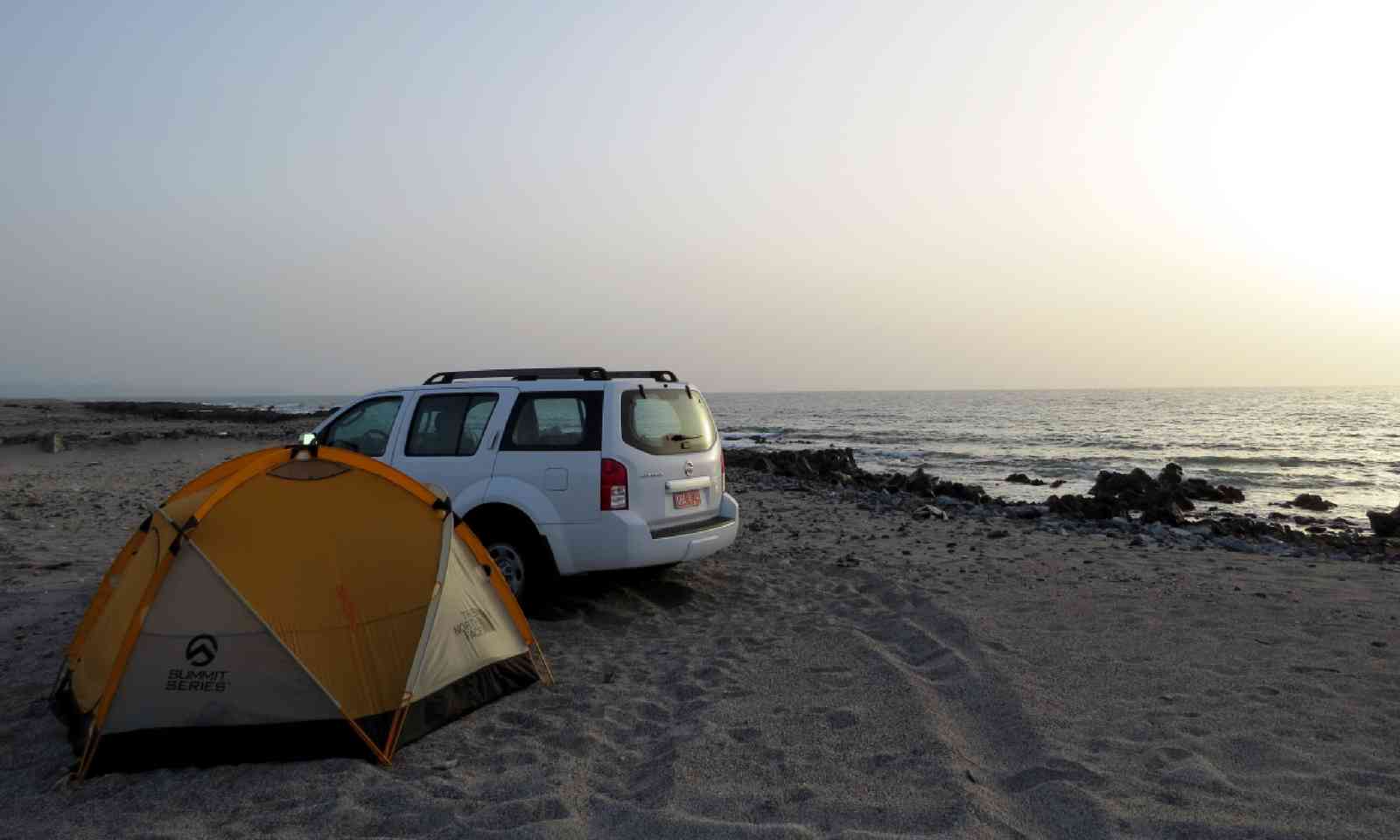
Wild camping on Masirah Island (Hazel Plush)
That night, I awoke as the moon brightened. We’d been lulled to sleep by the pounding sea, our road-weariness soothed by the air’s saltwater tang. Now the wind had dropped, the moon had risen, and the beach basked under a duvet of twinkling stars. I walked on the beach for a while, in my pyjamas, relishing the shiver of cold in the air.
A morning of adventure awaited: discovering deserted coves and wind-whipped beaches along the east coast. Windsurfers are Masirah’s only scant source of tourist income, but we hardly spotted anybody as we sank our feet into powder-soft sand, sought shade in crab-ridden caves, and found mini mountains of mother-of-pearl shells.

Fishing boats on east coast of Masirah Island (Hazel Plush)
“Go to the resort,” our boat’s skipper had suggested when we’d landed in Hilf. At the time, we’d scoffed at his suggestion. Who needed swimming pools and showers when you had the whole wild island to explore? But sweaty and sandy, and gasping for a glug of cold water, we drove up to its gates to ask for a day pass.
The afternoon passed in a haze of swimming pool dips, fruity cocktails and endless mango ice cream – like a proper holiday, except we had the place to ourselves.
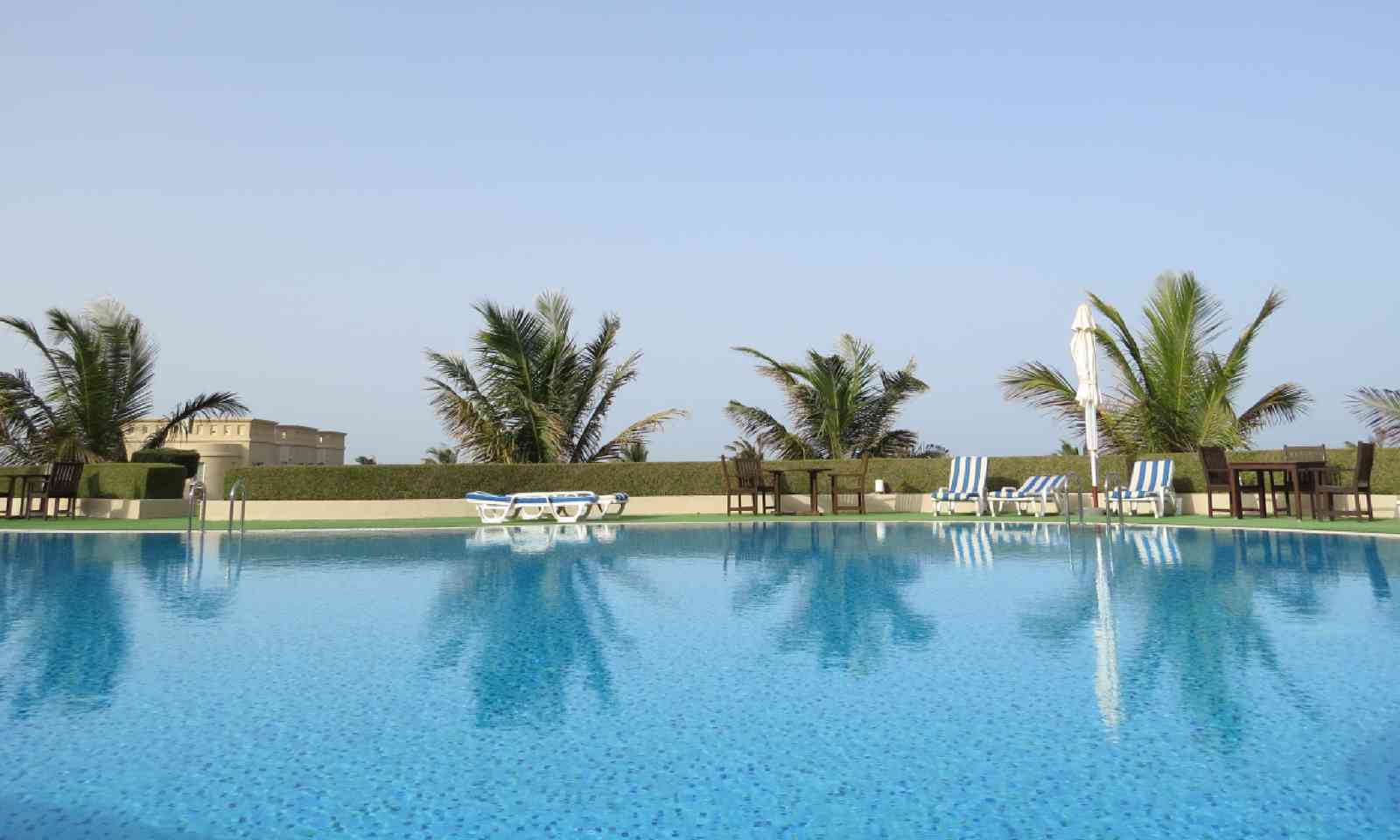
Masirah Island Resort (Hazel Plush)
That afternoon, feeling fresh and full, we drove south until we could go no further, yelping as we bounced between dunes and shouting to the setting sun. A golden sandbank stopped us: the end of Masirah. We cut the engine and looked out over the waves, scarlet and glittering like a sequinned evening dress. This was the spot – the very tip of the island.
We unfurled the tent and lit the stove, the routine familiar and soothing. As the water bubbled, I scooped up handfuls of sand and let the silken grains pour through my fingertips, revelling in the softness, the solitude, the silence.
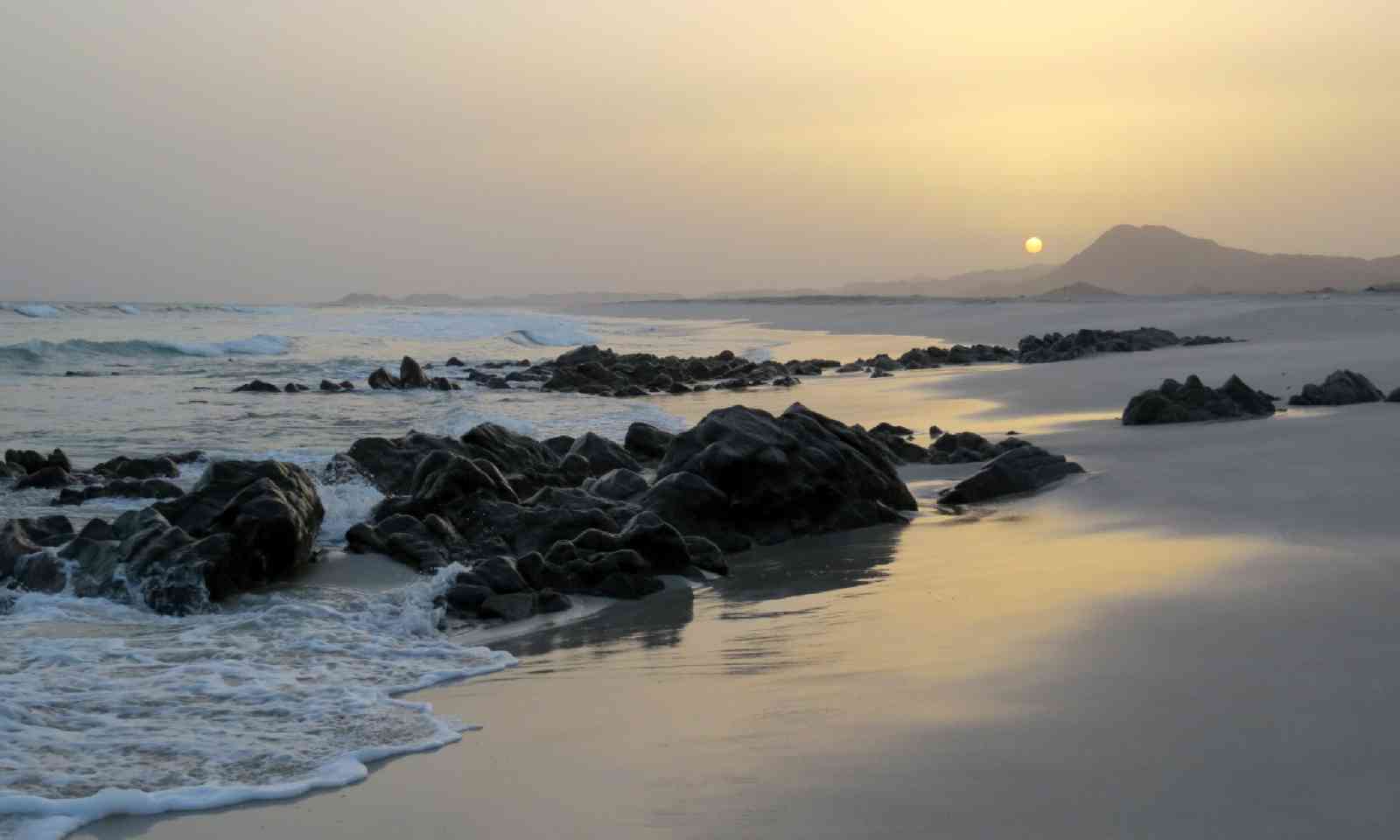
An incredible beach for wild camping, Masirah Island (Hazel Plush)
Eventually, we started to climb. Imperceptibly at first, but the gentle rise wasn’t the first thing to change. The scrubby bushes bloomed into wild flowers – hardy little pale things, but life nevertheless. For the first time in hours, houses popped up on the side of the highway. Our sand cloud disappeared, and I opened the window to let in great gulps of warm, fresh air.

Town of Bahla in the foothills of the Western Hajar (Shutterstock)
This was the edge of the Western Hajar, the untamed mountains where rivers, wildlife and – according to locals – naughty djin spirits run free. We rose higher, our ears popping with every upward curve of the road, losing our race against the setting sun. Eventually we caught sight of our hotel, glowing like a beacon on the black hillside.
At dawn, when I swooshed open the bedroom curtains, countless saw-toothed peaks grinned back at me – a widescreen view of neck-craning proportions. After days in the desert, the land as level as an Arabic flatbread, these great green-topped mountains felt perilously high. We sipped our coffee and edged closer to the end of the balcony, stunned by the difference in scenery.
“You haven't seen anything yet,” laughed our guide for the day, as we hopped into his 4WD. Born and bred in Nizwa, Ahmed knew the mountains trails inside out, and we were soon off-road, bouncing down dry wadis (riverbeds) as he told tales of djins and their black magic whimsy. “See that cave, up there? That's the home of a djin. He only comes out at night, to scare children.” A canny ploy, I thought, to stop your kids from venturing far.
As we drove into Wadi Nakhr, the rock walls got higher and narrower, and the boulders got bigger – until eventually, we had to explore on foot. We crunched alongside a trickling stream, under a sliver of blue sky sandwiched between sheer cliffs. I ran my fingertips over the silky smooth stone walls, relishing the scent of the gorge: fresh, wet, and a little goaty.
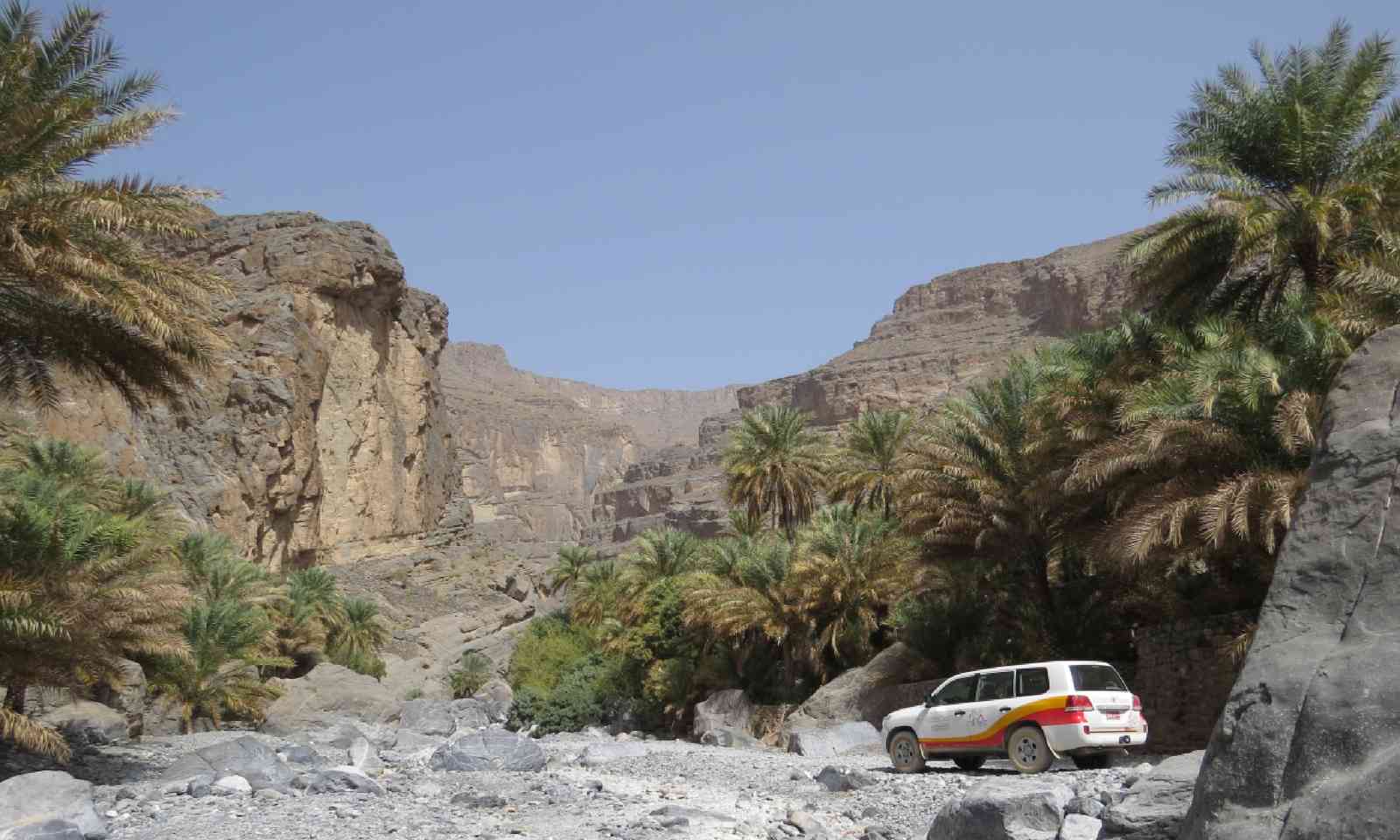
Wadi Nakhr (Hazel Plush)
Date palms and fruit trees flourish down in the canyon's cool depths, nurtured by river water and fertile soil. We snacked on a freshly-plucked mango while Ahmed pointed out pictures of camels and oryx antelopes, scratched onto the rock thousands of years ago.
Back in the car, we climbed from one end of the canyon to the other: up, up and not-too-far away, to it wide gaping mouth. The rocky plateau looked like it had been ripped from side to side, a vast tear in its smooth surface plummeting over 1,000 metres to the wadi below.
“This all used to be under the sea,” said Ahmed as we peered over the edge, our palms sweaty despite the cool high-altitude breeze. “You can find fossils in the rock, of sea creatures from millions of years ago. Jebel Shams was forced up from the ocean – and now it's the highest point in eastern Arabia.” A mob of goats skittered over the scree, sniffing hopefully at the sandwiches tucked in our bag – oblivious, it seemed, to the oblivion that lay at their feet.
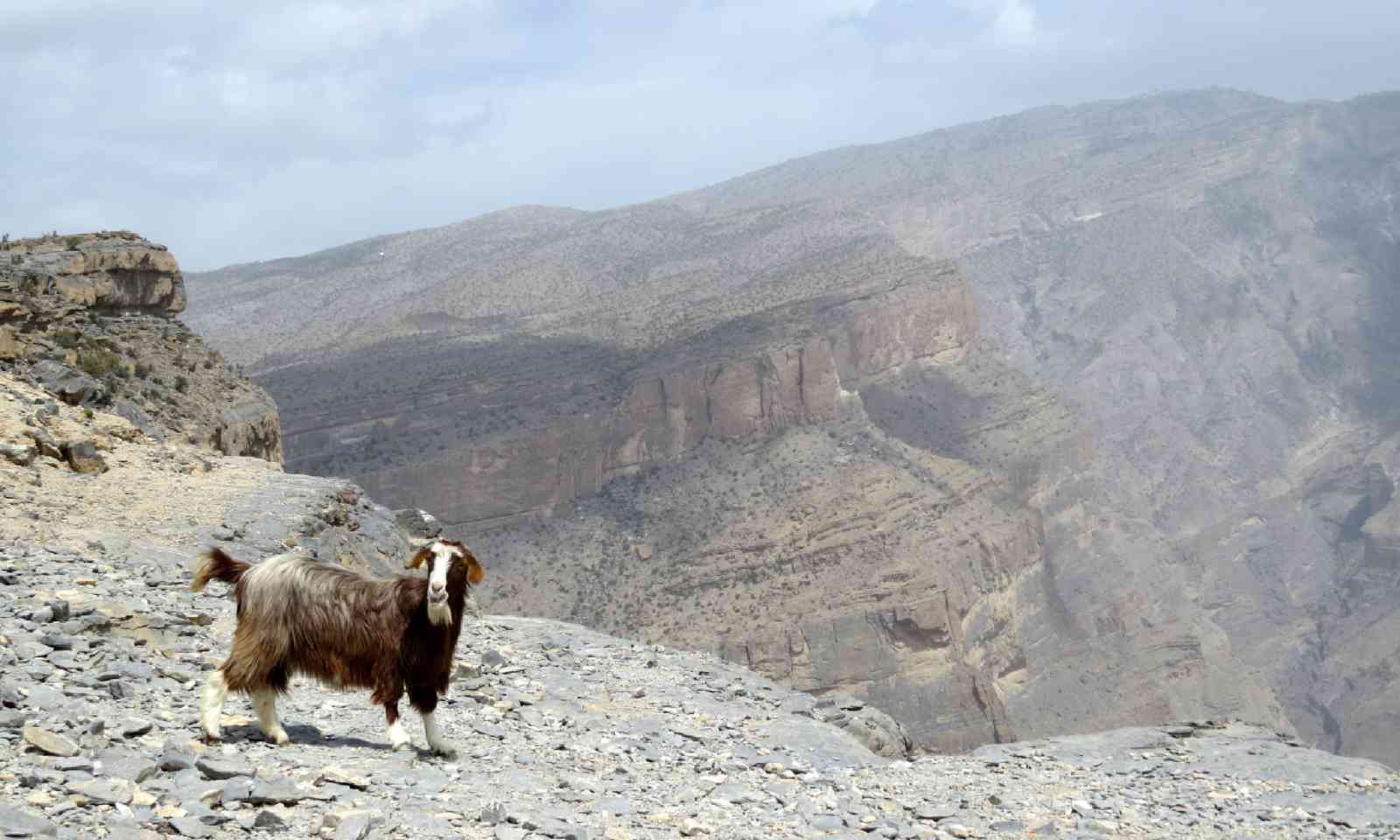
Goat at Jebel Shams (Hazel Plush)
We heeded his advice, gaining altitude with the road's every hairpin bend, eyeing Egyptian vultures circling in the darkening sky. We took a turn-off on a whim: there was no sign-post, just a slender track that broke free from the road, leading to who-knew-where. Cursing at the jagged rocks and deep potholes that littered our path, we edged along it, hungry and weary but not quite ready to admit defeat.
We didn’t expect the road to lead anywhere special – we thought we’d be camping in the scrub. But we emerged, awe-struck, onto a great sweeping plateau: our very own jebel. We stumbled out of the car, silenced by the view: hundreds of metres below us, date palms danced in the gloaming while the lights of a tiny village sprung into life. But up here we had only the breeze for company, and a scattering of stars.
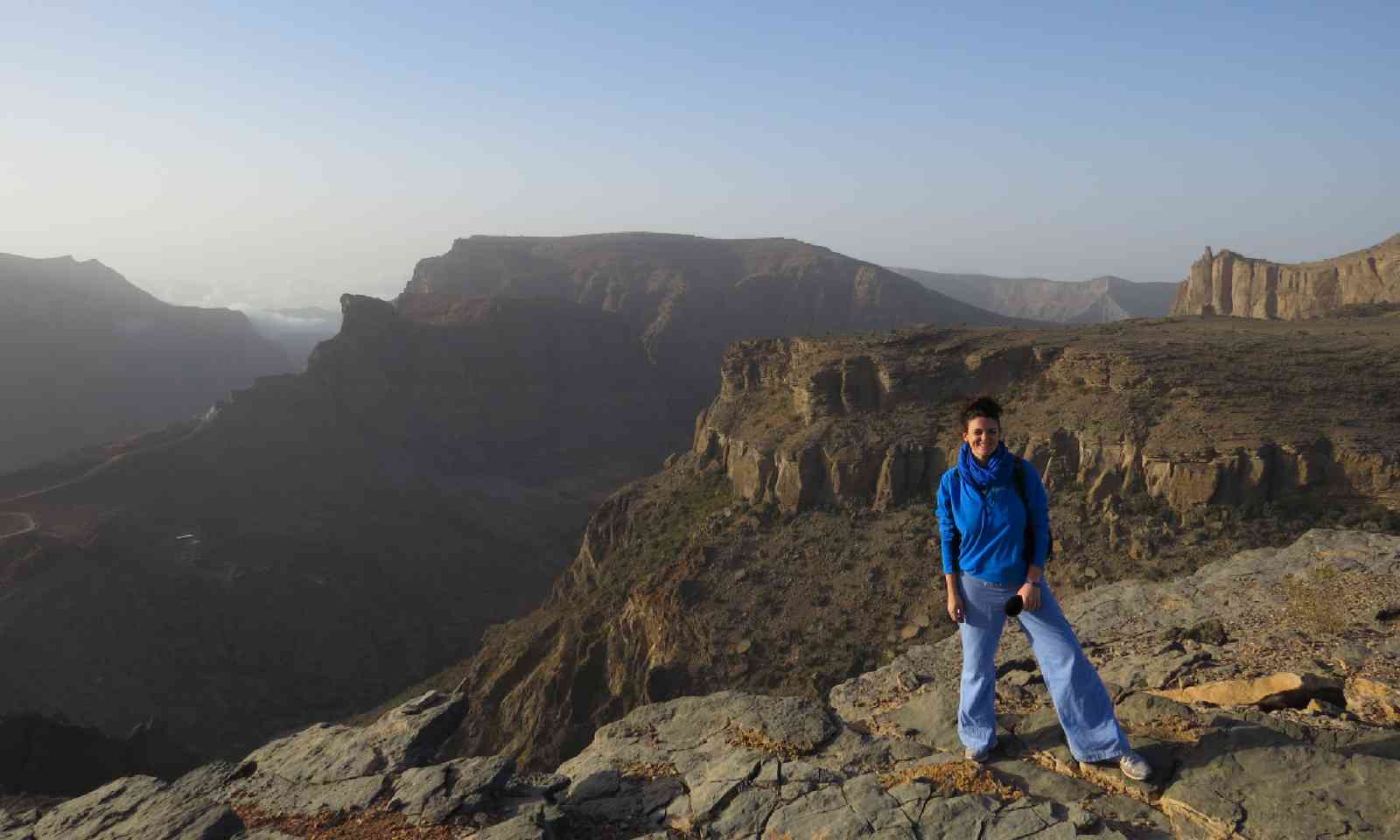
Camping in the Western Hajar mountains, at dawn (Hazel Plush)
Tomorrow we would return to Muscat, for two days of beach lazing and ice cream. But as I fossil hunted by the light of the moon, to the strains of the day’s last call to prayer, I knew nothing could get as good as this. You don’t have to look far to see the beauty of Oman, but with a bit of perseverance – and a good 4WD – you will find a land like no other. But be warned: you'll be compelled to return, just like the sea turtles on its wild, wonderful coastline.
Main image: Driving in the desert, Oman (Hazel Plush)
The turtle stopped her scooping, resting silently for a minute. She fixed us with an unblinking eye. The lights of distant fishing boats danced on the shimmering sea and a gentle wind whispered in our ears, but we barely noticed. This was the first night of our road trip along Oman’s untamed coast, a journey that had begun just a few hours ago – and we were already lost for words.
Innately programmed to lay – and bury – her eggs on the same beach where she had hatched, she had swum thousands of miles to Ras al Jinz beach just for this moment, from waters as far-flung as Yemen, Somalia and the Maldives. Like a hefty boulder, her metre-long shell was half-hidden by sand, her flippers limp at her sides.

Green turtle at Ras al Jinz (Dreamstime)
The screech of a mobile interrupted our reverie. “No cameras, no phones, no torches, no loud talking,” turtle ranger Hamad had warned at the start of the tour, lest we disturb the turtles. So when he fished his phone from his pocket, we bristled as he spoke in increasingly excitable Arabic.
“There is a group of newly-hatched turtles that are heading to the sea,” he translated. “Follow me!” All forgiven, we stumbled over the dunes in his wake, leaving the green turtle to her slog.
We were almost too late. A clutch of tiny turtles, each no bigger than my palm, were stumbling across the wet sand. They too were facing a Herculean task: to navigate the beach on flailing flippers and find the nearest wave.

Green turtle swimming off the coast of Oman (Shutterstock)
“They have beaten the odds to get to the sea,” whispered Hamad. He pointed to a patch of sand just metres away, cross-crossed with different animal tracks. “Those are the footprints of the foxes and crabs that feed on turtle eggs. The birds – see, circling up there? – they also eat them. Only about two in one thousand turtles survive until maturity.”
When the last of the hatchlings disappeared into the surf, we retraced our own footprints back to the mother turtle. She too was inching her way to the sea, ready to slip back into its shadowy waves. I glanced up at the gulls, eerily silent above us, and hoped that her long night of laying wasn’t in vain. A tide of seawater swooshed up the sand – and with that, the turtle was gone.
A lonely road
We left the following morning too, headed southwards to Shannah – finally on Oman’s open roads. I’d lived in the Middle East years before and had fallen hopelessly in love with the country, a peaceful jewel amongst its war-torn neighbours. I’d explored its cities on weekend jaunts, but never had the chance to venture far. Now was the time to give that itch a good scratch, in a rental 4WD jam-packed with camping gear.In just one week, my partner and I aimed to cover 1,300km, wild camping wherever we could. Our route, marked on a map in pink highlighter, would take us in a loop from Muscat down to Masirah Island – along the coast – before heading inland to the Western Hajar mountains. It was an ambitious plan, but Oman boasts an ever-growing network of fine roads and some of the cheapest fuel prices on the planet. A litre of super-unleaded petrol costs 120 Omani Baisa: just 20 pence.
The highway from Ras al Jinz to Shannah skirts the coastline, 300km of smooth asphalt sandwiched between sea and perilous sand dunes. As we ate up the kilometres, the turquoise ocean unfurled on our left, the occasional dhow fishing boat bobbing on the blue.
On our right, visions of picturebook Arabia: rolling white dunes, sizzling in the late morning sun. It was March, so temperatures hovered modestly in the mid twenties – but out there in the desert it looked hot, hot, hot.

Camels on the road – a common sight (Hazel Plush)
Signs warned of camels, a peril we only half-believed until we whizzed past a pair lolloping along the highway. As they shrank in the rear-view mirror, fuzzy with heat haze and dust, I wondered what they thought of this road through their desert home.
Until a few decades ago, there were only 9km of tarmac roads in the whole country. Oman was languishing under the oppressive rule of Said bin Taimur, its population impoverished and illiterate. Taimur confined the country’s wealth to his Muscat quarters, living in luxury while his subjects scratched out meagre livelihoods as farmers, traders, and fishermen.
But in July 1970, Taimur’s son seized power – and everything changed. Qaboos bin Said Al Said channelled the country’s oil money into education, amenities, roads and housing. “My father doesn’t recognise his country now,” our guide Ahmed had said on our first day’s tour of Muscat. “When he was a boy, he lived in one room with his parents and eight brothers – now, we have everything we could ever need. People love the Sultan.”
Sleeping at the wheel
We were welcomed to sleepy Shannah by a gaggle of goats and old men. The former skittered everywhere: in the road, on the petrol station forecourt, in the scrub-rich ditches around concrete-block houses. The latter lazed on benches and ripped-out car seats, propped up on the side of the street. ‘Ladies’ Readymade Garments’ declared a sun-bleached sign, but there were no women to be seen. They would be at home, I guessed, cooking and looking after the children.
Time for a quick coffee? (Hazel Plush)
I eyed the door of a weather-beaten coffee shop, a lone dog sleeping under its half-closed shutters. After three hours of driving, a hit of sweet cardamom-scented Arabic coffee would shake off the fug of the road – but there was no time to stop. We had a boat to catch, to Masirah Island.
In the harbour, a rusting car ferry rocked amongst an elegant fleet of wooden dhows. Their hand-crafted curves spoken of Oman’s seafaring traditions, the country’s love and deep respect for its bounteous waters. Our steed, however, chugged ungracefully as we boarded – the fifteenth and final vehicle on deck.
Out on the sapphire waves of the Arabian Gulf, we were tossed like bath toys by the ever-growing swell. There was nowhere to sit but the car, so I copied the local families, businessmen and traders around us, and reclined my seat for a kip. For 90 minutes we snoozed our way eastwards, in a cloud of diesel fumes and hopeful seagulls.

The car ferry to Masirah Island (Hazel Plush)
The wildest of camp sites
I rubbed my eyes – were those whale carcasses on the beach? As we edged closer to Hilf, Masirah’s main town, the curved skeletons came into focus: half-built dhow boats, the frames of their great underbellies lopsided on the sand. We trundled off the ferry and rolled down the windows, relishing the fresh air and the mosque’s call to prayer.Our destination? Unknown. We’d read about Masirah’s sprawling beaches – boundless stretches of untouched sand and towering dunes, perfect for wild camping. The island is just 95km long and 14 km wide, circled by a single road – so we threw caution to the wind and turned left, towards the waning sun.
It was the camels that led us to the perfect camping spot. We’d slowed to admire them as they sashayed along the beach, the golden fluff on their humps ruffling in the breeze. While I hung out of the window taking photos, my partner swung the car onto the shingle, facing the darkening sea. We’d arrived. The claps of the waves applauded our choice.

Wild camping on Masirah Island (Hazel Plush)
That night, I awoke as the moon brightened. We’d been lulled to sleep by the pounding sea, our road-weariness soothed by the air’s saltwater tang. Now the wind had dropped, the moon had risen, and the beach basked under a duvet of twinkling stars. I walked on the beach for a while, in my pyjamas, relishing the shiver of cold in the air.
Who needs a swimming pool?
The second time I woke, I was alone. Drawn outside by the smell of brewing coffee and the rising heat of the tent, I shielded my eyes from the sun’s glare: at 7am, its rays were already piercing. Down at the water’s edge in the shadow of a rock, we breakfasted on sweet dates and flatbread, cooling our toes in the surf.A morning of adventure awaited: discovering deserted coves and wind-whipped beaches along the east coast. Windsurfers are Masirah’s only scant source of tourist income, but we hardly spotted anybody as we sank our feet into powder-soft sand, sought shade in crab-ridden caves, and found mini mountains of mother-of-pearl shells.

Fishing boats on east coast of Masirah Island (Hazel Plush)
“Go to the resort,” our boat’s skipper had suggested when we’d landed in Hilf. At the time, we’d scoffed at his suggestion. Who needed swimming pools and showers when you had the whole wild island to explore? But sweaty and sandy, and gasping for a glug of cold water, we drove up to its gates to ask for a day pass.
The afternoon passed in a haze of swimming pool dips, fruity cocktails and endless mango ice cream – like a proper holiday, except we had the place to ourselves.

Masirah Island Resort (Hazel Plush)
That afternoon, feeling fresh and full, we drove south until we could go no further, yelping as we bounced between dunes and shouting to the setting sun. A golden sandbank stopped us: the end of Masirah. We cut the engine and looked out over the waves, scarlet and glittering like a sequinned evening dress. This was the spot – the very tip of the island.
We unfurled the tent and lit the stove, the routine familiar and soothing. As the water bubbled, I scooped up handfuls of sand and let the silken grains pour through my fingertips, revelling in the softness, the solitude, the silence.

An incredible beach for wild camping, Masirah Island (Hazel Plush)
Into the mountains
It didn’t last. The next day, we left the island, our pink highlighter scrawl leading all the way up to Jebel Shams – on a long, lonely road hewn out of nothing at all. Empty desert stretched out in every direction, miles and miles of the kind of sand that billows in your wake like the movies. The road sizzled. We passed a roadkill camel, its oozing belly blackened with flies. The sun soared and the air conditioning roared – and we sped onwards through the dust.Eventually, we started to climb. Imperceptibly at first, but the gentle rise wasn’t the first thing to change. The scrubby bushes bloomed into wild flowers – hardy little pale things, but life nevertheless. For the first time in hours, houses popped up on the side of the highway. Our sand cloud disappeared, and I opened the window to let in great gulps of warm, fresh air.

Town of Bahla in the foothills of the Western Hajar (Shutterstock)
This was the edge of the Western Hajar, the untamed mountains where rivers, wildlife and – according to locals – naughty djin spirits run free. We rose higher, our ears popping with every upward curve of the road, losing our race against the setting sun. Eventually we caught sight of our hotel, glowing like a beacon on the black hillside.
At dawn, when I swooshed open the bedroom curtains, countless saw-toothed peaks grinned back at me – a widescreen view of neck-craning proportions. After days in the desert, the land as level as an Arabic flatbread, these great green-topped mountains felt perilously high. We sipped our coffee and edged closer to the end of the balcony, stunned by the difference in scenery.
“You haven't seen anything yet,” laughed our guide for the day, as we hopped into his 4WD. Born and bred in Nizwa, Ahmed knew the mountains trails inside out, and we were soon off-road, bouncing down dry wadis (riverbeds) as he told tales of djins and their black magic whimsy. “See that cave, up there? That's the home of a djin. He only comes out at night, to scare children.” A canny ploy, I thought, to stop your kids from venturing far.
As we drove into Wadi Nakhr, the rock walls got higher and narrower, and the boulders got bigger – until eventually, we had to explore on foot. We crunched alongside a trickling stream, under a sliver of blue sky sandwiched between sheer cliffs. I ran my fingertips over the silky smooth stone walls, relishing the scent of the gorge: fresh, wet, and a little goaty.

Wadi Nakhr (Hazel Plush)
Date palms and fruit trees flourish down in the canyon's cool depths, nurtured by river water and fertile soil. We snacked on a freshly-plucked mango while Ahmed pointed out pictures of camels and oryx antelopes, scratched onto the rock thousands of years ago.
Back in the car, we climbed from one end of the canyon to the other: up, up and not-too-far away, to it wide gaping mouth. The rocky plateau looked like it had been ripped from side to side, a vast tear in its smooth surface plummeting over 1,000 metres to the wadi below.
“This all used to be under the sea,” said Ahmed as we peered over the edge, our palms sweaty despite the cool high-altitude breeze. “You can find fossils in the rock, of sea creatures from millions of years ago. Jebel Shams was forced up from the ocean – and now it's the highest point in eastern Arabia.” A mob of goats skittered over the scree, sniffing hopefully at the sandwiches tucked in our bag – oblivious, it seemed, to the oblivion that lay at their feet.

Goat at Jebel Shams (Hazel Plush)
A serendipitous spot
When he dropped us off at the hotel, Ahmed tittered at our plans to wild camp in the mountains. “There is a storm coming in from Iran,” he warned, “so you must head up high. If it rains and the wadi floods, you could be swept away.”We heeded his advice, gaining altitude with the road's every hairpin bend, eyeing Egyptian vultures circling in the darkening sky. We took a turn-off on a whim: there was no sign-post, just a slender track that broke free from the road, leading to who-knew-where. Cursing at the jagged rocks and deep potholes that littered our path, we edged along it, hungry and weary but not quite ready to admit defeat.
We didn’t expect the road to lead anywhere special – we thought we’d be camping in the scrub. But we emerged, awe-struck, onto a great sweeping plateau: our very own jebel. We stumbled out of the car, silenced by the view: hundreds of metres below us, date palms danced in the gloaming while the lights of a tiny village sprung into life. But up here we had only the breeze for company, and a scattering of stars.

Camping in the Western Hajar mountains, at dawn (Hazel Plush)
Tomorrow we would return to Muscat, for two days of beach lazing and ice cream. But as I fossil hunted by the light of the moon, to the strains of the day’s last call to prayer, I knew nothing could get as good as this. You don’t have to look far to see the beauty of Oman, but with a bit of perseverance – and a good 4WD – you will find a land like no other. But be warned: you'll be compelled to return, just like the sea turtles on its wild, wonderful coastline.
Main image: Driving in the desert, Oman (Hazel Plush)


